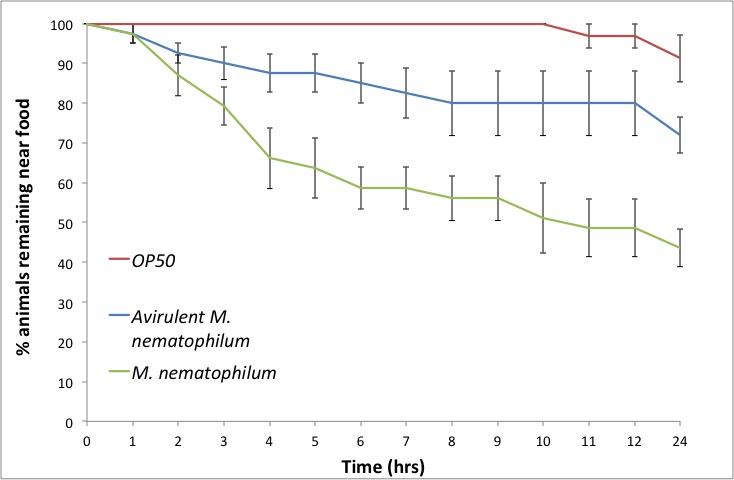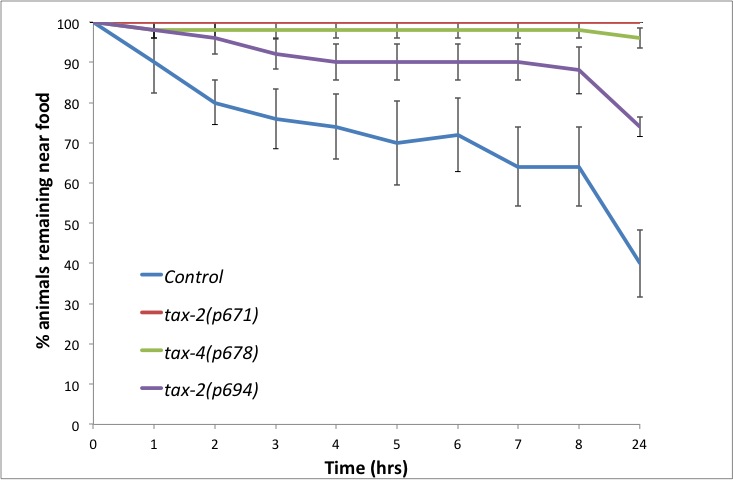C. elegans constantly encounter pathogenic threats and the ability to recognize and avoid these threats is crucial to survival. C. elegans have evolved a variety of immediate and learned behavioral responses to minimize pathogen exposure (Yook and Hodgkin, 2007; McMullan et al., 2012; and others). Behavioral responses to pathogens are commonly investigated using a food choice assay where animals are given a choice between their standard laboratory food, OP50, and the pathogen of interest (Yook and Hodgkin, 2007; McMullan et al. 2012). The results of this type of assay integrate both the known attractive effect of OP50 and the attractive/repellent effect of the pathogen under investigation. In order to examine only potential repellent cues, we have adapted the male leaving assay (Lipton et al., 2004) to analyze the response of naïve animals upon exposure to Microbacterium nematophilum, a gram positive bacteria which binds to and colonizes the rectal opening of C. elegans.
Method: 90 mm NGM assay plates were prepared using 13 ml NGM in order to make animals tracks easier to observe. Bacterial cultures were grown to OD600 = 1.0 before plating 20 µl in the center of the assay plate.
Single synchronized young adult hermaphrodites were transferred onto individual plates. 10 plates were prepared for each bacterial lawn to be tested.
Plates were kept at 20 oC and examined at 1 hr intervals to determine if the animal was a leaver, meaning that the animal or its tracks can been seen 1 cm or less from the edge of the plate. Animals determined to have left were not scored again at later time points
Results: Animals placed on plates seeded with OP50 show little leaving behaviour over 24 hrs. An avirulent M. nematophilum strain (Akimkina et al., 2006) induces a limited leaving response, whilst virulent M. nematophilum induces a rapid response over 24 hrs (Figure 1).
Using this assay we tested the role of the cyclic nucleotide gated ion channel TAX-2/TAX-4 in this behaviour. This pathway has been shown to be required for wild type responses to M. nematophilum using a food choice assay (Yook and Hodgkin 2007). Avoidance of M. nematophilum depends on TAX-2/TAX-4, since mutations in either TAX-2 or TAX-4 abrogate the leaving response (Figure 2). In wild-type animals TAX-2/TAX-4 is expressed in AWC, AFD, ASE, ASG, ASJ, AQR, BAG, ASK, ASI, AWB, and PQR (Coburn and Bargmann, 1996). The allele tax-2(p694) has a deletion in the promoter region and first exon of tax-2 abolishing its expression in ASE, AQR, AFD, and BAG (Coburn and Bargmann, 1996). In contrast to the response to M. nematophilum in a food choice assay (Yook and Hodgkin, 2007), tax-2(p694) animals show a defective leaving response particularly at longer time points (Figure 2), suggesting these four cells are important for the normal leaving response to this pathogen.
This simple behavioural assay could be adapted to investigate the response to numerous pathogens and removes the influence of the attractive cue from OP50 in food choice assays.
Acknowledgements: We thank Arantza Barrios (University College London) and Richard Poole (University College London) for suggestions and assistance in setting up this assay. We thank Jonathan Hodgkin for M. nematophilum strains.
Figures
References
Akimkina T, Yook K, Curnock S, and Hodgkin J. (2006). Genome characterization, analysis of virulence and transformation of Microbacterium nematophilum, a coryneform pathogen of the nematode Caenorhabditis elegans. FEMS Microbiol. Lett. 264, 145–151. 
Coburn CM, and Bargmann CI. (1996). A putative cyclic nucleotide-gated channel is required for sensory development and function in C. elegans. Neuron 17, 695–706. 
Lipton J, Kleemann G, Ghosh R, Lints R, and Emmons SW. (2004). Mate searching in Caenorhabditis elegans: a genetic model for sex drive in a simple invertebrate. J. Neurosci. 24, 7427-7434. 
McMullan R, Anderson A, and Nurrish S. (2012). Behavioral and immune responses to infection require Gαq-RhoA signaling in C. elegans. PLoS Pathog 8, e1002530. 
Yook, K. and Hodgkin J. (2007). Mos1 mutagenesis reveals a diversity of mechanisms affecting response of Caenorhabditis elegans to the bacterial pathogen Microbacterium nematophilum. Genetics 175, 681-697. 
Articles submitted to the Worm Breeder's Gazette should not be cited in bibliographies. Material contained here should be treated as personal communication and cited as such only with the consent of the author.


Leave a Reply
You must be logged in to post a comment.